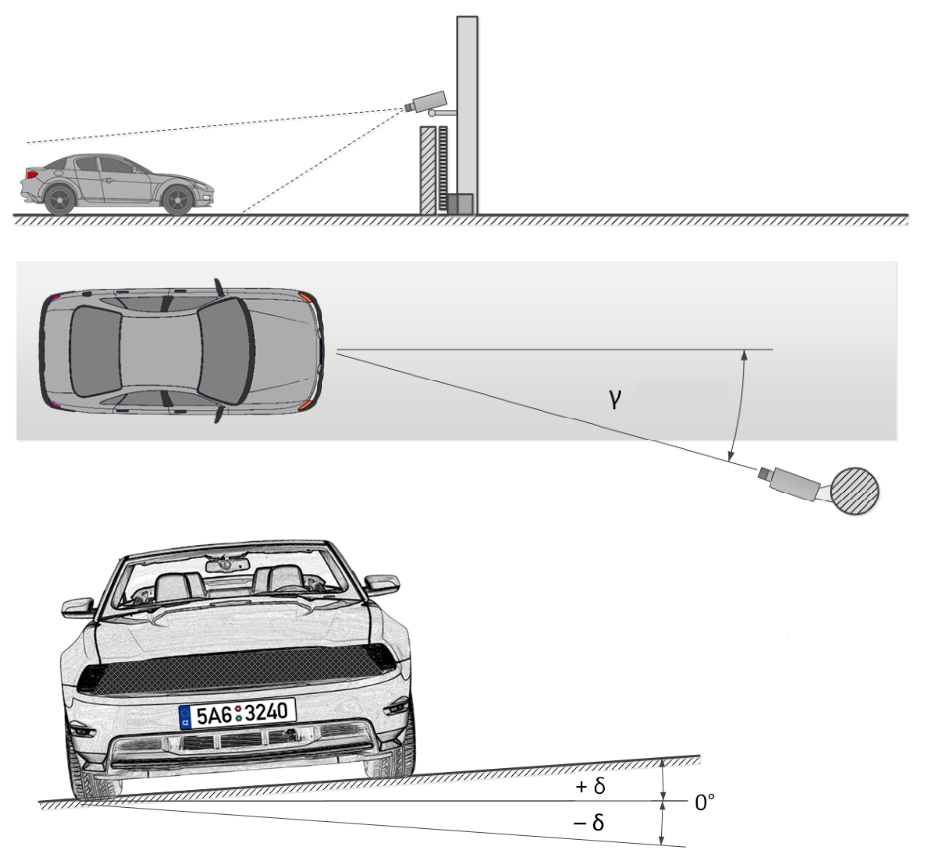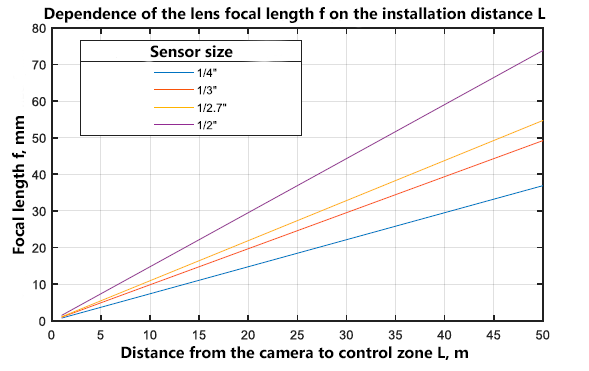Requirements and recommendations for the License Plate Recognition module🔗
Software environment requirements
Warning
When using Windows OS, the License Plate Recognition module only works on Windows 10 and newer, Windows Server 2016 and newer.
Hardware requirements
It requires the Intel CORE I3-10100 or higher processor (CPU) to use the module on a surveillance server.
The module can run without a video card.
When the module runs in graphics card mode, it requires a NVIDIA graphics card (GPU) with features and performance not lower than the NVIDIA GTX 1650 model.
Camera installation requirements
Maximum allowable tilt and rotation angles for the camera:
Maximum allowable vertical tilt angle: 35°.
Maximum allowable horizontal tilt angle: 35°.
Maximum allowable rotation angle of the license plate's horizontal axis relative to the camera's axis: 35°.

Video stream requirements
Resolution: not less than 1280⨯720 (HD) (provided that the character size requirements of the license plate are met).
Frame rate:
not less than 20 frames per second for the fast mode
not less than 10 frames per second for the medium and slow modes
Requirements to the license plate image
The license plate can be detected, and the registration number on it can be recognized under the following conditions:
The license plate is fully visible in the frame (not obscured by other objects and does not extend beyond the frame boundaries).
The minimum height of the recognizable characters should be no less than 15 pixels (country code characters are not considered recognizable characters).

The image of the license plate and its characters should be high-contrast, free from noise, and not blurred.
The license plate text is correctly recognized both in color and black-and-white images.
The color of the license plate is recognized only in color images.
Recommendations on choosing and setting up a camera and lens
When choosing a camera for the license plate recognition purposes, be guided by the above requirements for the received image and recommendations for the camera mounting, as well as the following recommendations for the stream generation settings. Note that some features and settings may be not presented in the description and/or design of specific cameras.
To form a high-quality image of the license plate in motion, the camera should be able to set a fixed exposure time or limit the exposure value to avoid blurring caused by high movement speed. If the camera supports only the possibility to set a fixed exposure time, then it must additionally have a lens with automatic iris control (ALC) like DC-Iris or P-Iris to adjust the amount of light, coming to the sensor. At the same time, if the camera allows to set a limit on the maximum exposure time, then the lens without ALC can be used. In this case, the camera will automatically adjust the exposure depending on the illumination of the control area, but the exposure value will not be higher than the set value, which will help to eliminate high-speed blurring.
Warning
Some modern cameras may have both the ability to set a fixed exposure time and equipped with an ARD lens. It should be borne in mind that for such cameras, ARD does not work at a fixed shutter speed.
Recommended shutter speed (exposure) values depending on the speed of vehicles:
Maximum vehicle speed in the control area (kmph) |
Recommended shutter speed (sec) |
|---|---|
30 |
1/500 |
70 |
1/1000 |
150 |
1/2000 |
Note
The actual shutter speed is not limited by these values and can be increased to get images of fast-moving vehicles sharp enough for license plate recognition.
It is recommended to adjust and install the camera in such a way that the license plate of passing vehicles can be detected and recognized in the frame at least 3⨯N times, where N is the chosen value for the setting Number of license plate frames required for recognition. It should be noted that the setting Mode controls the frame processing frequency within the module. Thus, depending on the selected mode, the actual frame rate within the module will be:
Fast: 10 frames per second
Medium: 5 frames per second
Slow: 2.5 frames per second
Example: A car passes by in a manner that its license plate satisfies recognition conditions for 1.4 seconds. If the fast mode is selected, the module will see it approximately in 1.4⨯10 = 14 frames. Based on this, the maximum value for the setting Number of license plate frames required for recognition will be N=14/3 = 4 (dividing without remainder). In the medium mode, the maximum value for this setting will be 1.4⨯5/3 = 2, as the module in this mode processes frames only at a frequency of 5 FPS. When choosing higher values for the setting Number of license plate frames required for recognition or more economical values for the setting Mode the sensitivity of license plate detection will decrease.
The sensitivity of a camera is important for creating high-quality images of a moving license plate. It is recommended to use cameras with a sensitivity of 0.01 lux or less (the lower the better). If the sensitivity of the camera is insufficient, then more powerful additional lighting of the control area is required.
The focal length of the lens determines the angle of view of the camera, which affects the size of the license plate in the image. For reliable recognition, the size of a single-line license plate in the image must be at least 120x20 pixels by width and height. The illustration below shows the dependence of the focal length of the lens on the installation distance of the camera and the size of its photosensitive sensor.
